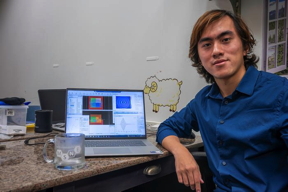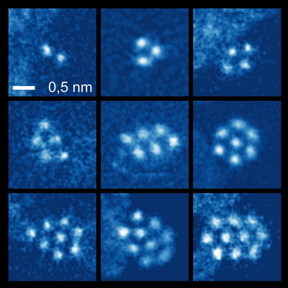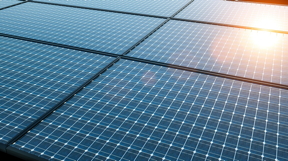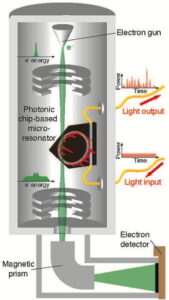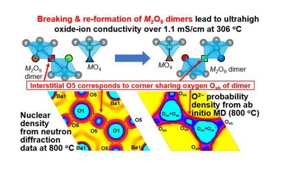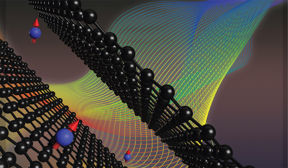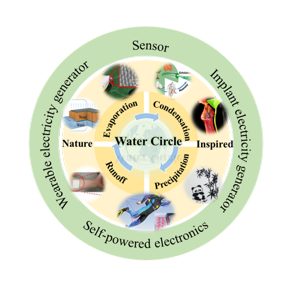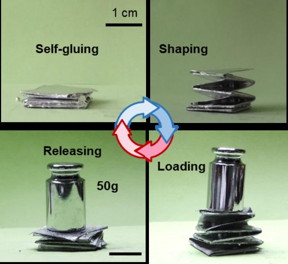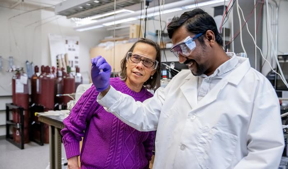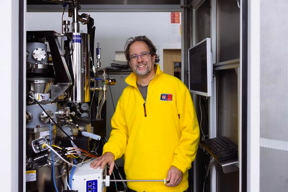Home > Press > Billions of nanoplastics released when microwaving baby food containers: Exposure to plastic particles kills up to 75% of cultured kidney cells
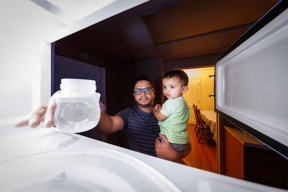 |
| Kazi Albab Hussain (left) holds his son while removing a plastic container of water from a microwave. Hussain and colleagues at the University of Nebraska–Lincoln have found that microwaving such containers can release up to billions of nanoscopic particles and millions of microscopic ones. CREDIT Craig Chandler, University of Nebraska–Lincoln |
Abstract:
The fastest way to heat food and drink might also rank as the fastest route to ingesting massive quantities of minuscule plastic particles, says new research from the University of Nebraska–Lincoln.
Billions of nanoplastics released when microwaving baby food containers: Exposure to plastic particles kills up to 75% of cultured kidney cells
Lincoln, NE | Posted on July 21st, 2023Experiments have shown that microwaving plastic baby food containers available on the shelves of U.S. stores can release huge numbers of plastic particles — in some cases, more than 2 billion nanoplastics and 4 million microplastics for every square centimeter of container.
Though the health effects of consuming micro- and nanoplastics remain unclear, the Nebraska team further found that three-quarters of cultured embryonic kidney cells had died after two days of being introduced to those same particles. A 2022 report from the World Health Organization recommended limiting exposure to such particles.
“It is really important to know how many micro- and nanoplastics we are taking in,” said Kazi Albab Hussain, the study’s lead author and a doctoral student in civil and environmental engineering at the University of Nebraska–Lincoln. “When we eat specific foods, we are generally informed or have an idea about their caloric content, sugar levels, other nutrients. I believe it’s equally important that we are aware of the number of plastic particles present in our food.
“Just as we understand the impact of calories and nutrients on our health, knowing the extent of plastic particle ingestion is crucial in understanding the potential harm they may cause. Many studies, including ours, are demonstrating that the toxicity of micro- and nanoplastics is highly linked to the level of exposure.”
The team embarked on its study in 2021, the same year that Hussain became a father. While prior research had investigated the release of plastic particles from baby bottles, the team realized that no studies had examined the sorts of plastic containers and pouches that Hussain found himself shopping for, and that millions of other parents regularly do, too.
Hussain and his colleagues decided to conduct experiments with two baby food containers made from polypropylene and a reusable pouch made of polyethylene, both plastics approved by the U.S. Food and Drug Administration. In one experiment, the researchers filled the containers with either deionized water or 3% acetic acid — the latter intended to simulate dairy products, fruits, vegetables and other relatively acidic consumables — then heated them at full power for three minutes in a 1,000-watt microwave. Afterward, they analyzed the liquids for evidence of micro- and nanoplastics: the micro being particles at least 1/1,000th of a millimeter in diameter, the nano any particles smaller.
The actual number of each particle released by the microwaving depended on multiple factors, including the plastic container and the liquid within it. But based on a model that factored in particle release, body weight, and per-capita ingestion of various food and drink, the team estimated that infants drinking products with microwaved water and toddlers consuming microwaved dairy products are taking in the greatest relative concentrations of plastic. Experiments designed to simulate the refrigeration and room-temperature storage of food or drink over a six-month span also suggested that both could lead to the release of micro- and nanoplastics.
“For my baby, I was unable to completely avoid the use of plastic,” Hussain said. “But I was able to avoid those (scenarios) which were causing more of the release of micro- and nanoplastics. People also deserve to know those, and they should choose wisely.”
With the help of Svetlana Romanova from the University of Nebraska Medical Center, the team then cultured and exposed embryonic kidney cells to the actual plastic particles released from the containers — a first, as far as Hussain can tell. Rather than introduce just the number of particles released by one container, the researchers instead exposed the cells to particle concentrations that infants and toddlers might accumulate over days or from multiple sources.
After two days, just 23% of kidney cells exposed to the highest concentrations had managed to survive — a much higher mortality rate than that observed in earlier studies of micro- and nanoplastic toxicity. The team suspects that kidney cells might be more susceptible to the particles than are other cell types examined in prior research. But those earlier studies also tended to examine the effects of larger polypropylene particles, some of them potentially too large to penetrate cells. If so, the Hussain-led study could prove especially sobering: Regardless of its experimental conditions, the Husker team found that polypropylene containers and polyethylene pouches generally release about 1,000 times more nanoplastics than microplastics.
The question of cell infiltration is just one among many that will require answers, Hussain said, before determining the true risks of consuming micro- and nanoplastics. But to the extent that they do pose a health threat — and that plastics remain a go-to for baby food storage — parents would have a vested interest in seeing that the companies manufacturing plastic containers seek out viable alternatives, he said.
“We need to find the polymers which release fewer (particles),” Hussain said. “Probably, researchers will be able to develop plastics that do not release any micro- or nanoplastics — or, if they do, the release would be negligible.
“I am hopeful that a day will come when these products display labels that read ‘microplastics-free’ or ‘nanoplastics-free.’”
The team reported its findings in the journal Environmental Science & Technology. Hussain and Romanova authored the study with the University of Nebraska–Lincoln’s Yusong Li, Mathias Schubert, Yongfeng Lu, Lucía Fernández-Ballester, Bing Wang, Xi Huang, Jesse Kuebler, Dong Zhang and Ilhami Okur. The researchers received support from the National Science Foundation and the Buffett Early Childhood Institute.
####
For more information, please click here
Contacts:
Media Contact
Scott Schrage
University of Nebraska-Lincoln
Expert Contact
Kazi Albab Hussain
University of Nebraska–Lincoln
Copyright © University of Nebraska-Lincoln
If you have a comment, please Contact us.Issuers of news releases, not 7th Wave, Inc. or Nanotechnology Now, are solely responsible for the accuracy of the content.
| Related Links |
| Related News Press |
News and information
![]() The present and future of computing get a boost from new research July 21st, 2023
The present and future of computing get a boost from new research July 21st, 2023
![]() Understanding the diverse industrial applications of materials science: Materials Science A Field of Diverse Industrial Applications July 21st, 2023
Understanding the diverse industrial applications of materials science: Materials Science A Field of Diverse Industrial Applications July 21st, 2023
Possible Futures
![]() Two types of ultrafast mode-locking operations generation from an Er-doped fiber laser based on germanene nanosheets July 21st, 2023
Two types of ultrafast mode-locking operations generation from an Er-doped fiber laser based on germanene nanosheets July 21st, 2023
![]() Detection of bacteria and viruses with fluorescent nanotubes July 21st, 2023
Detection of bacteria and viruses with fluorescent nanotubes July 21st, 2023
![]() A non-covalent bonding experience: Scientists discover new structures for unique hybrid materials by altering their chemical bonds July 21st, 2023
A non-covalent bonding experience: Scientists discover new structures for unique hybrid materials by altering their chemical bonds July 21st, 2023
Discoveries
![]() Understanding the diverse industrial applications of materials science: Materials Science A Field of Diverse Industrial Applications July 21st, 2023
Understanding the diverse industrial applications of materials science: Materials Science A Field of Diverse Industrial Applications July 21st, 2023
![]() A non-covalent bonding experience: Scientists discover new structures for unique hybrid materials by altering their chemical bonds July 21st, 2023
A non-covalent bonding experience: Scientists discover new structures for unique hybrid materials by altering their chemical bonds July 21st, 2023
![]() Researchers put a new twist on graphite July 21st, 2023
Researchers put a new twist on graphite July 21st, 2023
Announcements
![]() Understanding the diverse industrial applications of materials science: Materials Science A Field of Diverse Industrial Applications July 21st, 2023
Understanding the diverse industrial applications of materials science: Materials Science A Field of Diverse Industrial Applications July 21st, 2023
![]() A non-covalent bonding experience: Scientists discover new structures for unique hybrid materials by altering their chemical bonds July 21st, 2023
A non-covalent bonding experience: Scientists discover new structures for unique hybrid materials by altering their chemical bonds July 21st, 2023
Interviews/Book Reviews/Essays/Reports/Podcasts/Journals/White papers/Posters
![]() The present and future of computing get a boost from new research July 21st, 2023
The present and future of computing get a boost from new research July 21st, 2023
![]() Understanding the diverse industrial applications of materials science: Materials Science A Field of Diverse Industrial Applications July 21st, 2023
Understanding the diverse industrial applications of materials science: Materials Science A Field of Diverse Industrial Applications July 21st, 2023
![]() Researchers put a new twist on graphite July 21st, 2023
Researchers put a new twist on graphite July 21st, 2023
Environment
![]() A non-covalent bonding experience: Scientists discover new structures for unique hybrid materials by altering their chemical bonds July 21st, 2023
A non-covalent bonding experience: Scientists discover new structures for unique hybrid materials by altering their chemical bonds July 21st, 2023
![]() New single-photon Raman lidar can monitor for underwater oil leaks: System could be used aboard underwater vehicles for many applications June 30th, 2023
New single-photon Raman lidar can monitor for underwater oil leaks: System could be used aboard underwater vehicles for many applications June 30th, 2023
![]() When all details matter -- Heat transport in energy materials June 9th, 2023
When all details matter -- Heat transport in energy materials June 9th, 2023
Safety-Nanoparticles/Risk management
![]() Advances in nanotechnology application in biosafety materials A crucial response to COVID-19 pandemic June 9th, 2023
Advances in nanotechnology application in biosafety materials A crucial response to COVID-19 pandemic June 9th, 2023
![]() Underwater movement sensor alerts when a swimmer might be drowning October 7th, 2022
Underwater movement sensor alerts when a swimmer might be drowning October 7th, 2022
![]() New protocol for assessing the safety of nanomaterials July 1st, 2022
New protocol for assessing the safety of nanomaterials July 1st, 2022
![]() Nylon cooking bags, plastic-lined cups can release nanoparticles into liquids April 22nd, 2022
Nylon cooking bags, plastic-lined cups can release nanoparticles into liquids April 22nd, 2022
- SEO Powered Content & PR Distribution. Get Amplified Today.
- PlatoData.Network Vertical Generative Ai. Empower Yourself. Access Here.
- PlatoAiStream. Web3 Intelligence. Knowledge Amplified. Access Here.
- PlatoESG. Automotive / EVs, Carbon, CleanTech, Energy, Environment, Solar, Waste Management. Access Here.
- BlockOffsets. Modernizing Environmental Offset Ownership. Access Here.
- Source: http://www.nanotech-now.com/news.cgi?story_id=57370
- :is
- :not
- $UP
- 000
- 1
- 10
- 1st
- 2021
- 2022
- 21st
- 28
- 30th
- 7th
- 9th
- a
- Able
- About
- Accumulate
- accuracy
- actual
- administration
- After
- alerts
- All
- also
- alternatives
- am
- among
- an
- analyzed
- and
- answers
- any
- Application
- applications
- approved
- April
- ARE
- AS
- Assessing
- At
- author
- available
- avoid
- aware
- Baby
- Bacteria
- bags
- based
- BE
- became
- before
- being
- believe
- Billion
- billions
- Bing
- body
- boost
- both
- burn
- but
- by
- CAN
- cases
- Catalyst
- Cause
- causing
- cell
- Cells
- Center
- CGI
- chemical
- Choose
- click
- colleagues
- COM
- come
- comment
- Companies
- completely
- computing
- conditions
- Conduct
- Container
- Containers
- content
- cooking
- could
- COVID-19
- Craig
- credit
- crucial
- Cut
- dairy
- dance
- day
- Days
- decided
- demonstrate
- demonstrating
- deserve
- designed
- details
- determining
- develop
- died
- discover
- Display
- diverse
- do
- dramatically
- Drink
- drug
- dynamics
- each
- Earlier
- Early
- eat
- effects
- either
- Electronic
- enable
- end
- energy
- Engineering
- Engines
- environmental
- equally
- especially
- estimated
- Ether (ETH)
- Every
- evidence
- examine
- experience
- experiment
- experiments
- exposed
- Exposure
- extent
- factored
- factors
- far
- fastest
- fewer
- field
- filled
- Find
- findings
- First
- food
- Food and Drug Administration
- foods
- For
- found
- Foundation
- Frequency
- from
- Fruits
- full
- further
- future
- future of computing
- GAS
- generally
- generation
- get
- gif
- greatest
- greenhouse gas
- had
- harm
- Have
- he
- Health
- help
- higher
- highest
- highly
- his
- holds
- hopeful
- How
- http
- HTTPS
- huang
- huge
- Hybrid
- i
- idea
- if
- Impact
- important
- in
- Inc.
- Including
- industrial
- information
- informed
- instead
- Institute
- intended
- interest
- into
- introduce
- introduced
- IT
- ITS
- journal
- jpg
- July
- june
- just
- just one
- kidney
- Kills
- Know
- Knowing
- Labels
- large
- larger
- laser
- lasers
- lead
- Leaks
- least
- left
- Level
- levels
- li
- lidar
- Lincoln
- linked
- links
- Liquid
- made
- managed
- manufacturing
- many
- massive
- materials
- Matter
- May..
- medical
- metal
- methane
- micro
- might
- million
- millions
- minutes
- model
- Monitor
- more
- movement
- much
- multiple
- my
- nano
- nanotechnology
- National
- National Science
- Natural
- Natural Gas
- ne
- Nebraska
- Need
- net
- New
- news
- nexus
- no
- now
- nuclear
- number
- numbers
- observed
- october
- of
- Oil
- on
- ONE
- ones
- Operations
- or
- organization
- Other
- our
- out
- over
- parents
- particle
- People
- PHP
- plastic
- plastics
- plato
- Plato Data Intelligence
- PlatoData
- please
- Pollution
- Polymers
- Post
- posted
- potential
- potentially
- power
- present
- press
- Press Release
- Prior
- Products
- properties
- protocol
- Prove
- put
- Quantum
- question
- range
- rank
- Rate
- rather
- Read
- realized
- really
- received
- recommended
- Regardless
- regularly
- relative
- relatively
- release
- released
- Releases
- remain
- remove
- removing
- report
- Reported
- require
- research
- researchers
- response
- responsible
- return
- reusable
- reveal
- Revealed
- risks
- Route
- s
- Safety
- Said
- same
- Save
- says
- scenarios
- Science
- scientists
- Search
- seeing
- Seek
- Share
- shelves
- Shopping
- should
- shown
- smaller
- So
- sobering
- solely
- some
- son
- Sources
- span
- specific
- square
- start
- storage
- stores
- Student
- studies
- Study
- submit
- such
- sugar
- support
- survive
- susceptible
- system
- taking
- team
- Technology
- tell
- than
- that
- The
- the world
- their
- Them
- then
- These
- they
- this
- those
- threat
- three
- times
- to
- too
- transport
- true
- twist
- two
- types
- u.s.
- unable
- understand
- understanding
- underwater
- unique
- university
- us
- use
- used
- various
- Vegetables
- Vehicles
- viable
- viruses
- was
- Water
- Wave
- Way..
- we
- weight
- were
- when
- which
- while
- wide
- Wide range
- will
- with
- within
- world
- World Health Organization
- would
- xi
- Yahoo
- year
- you
- zephyrnet











